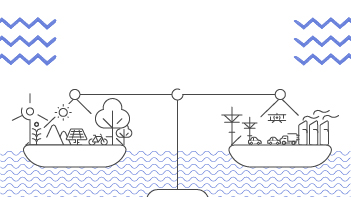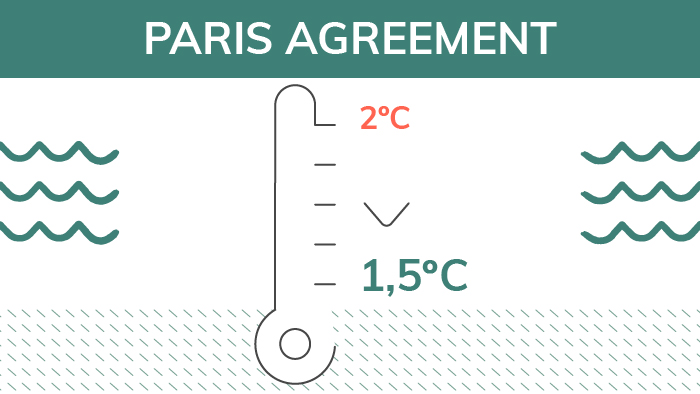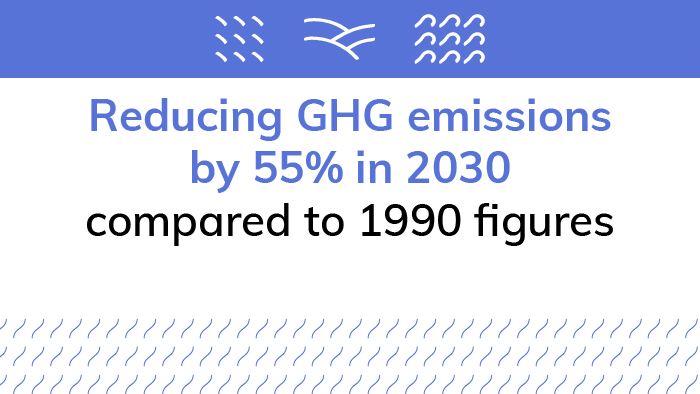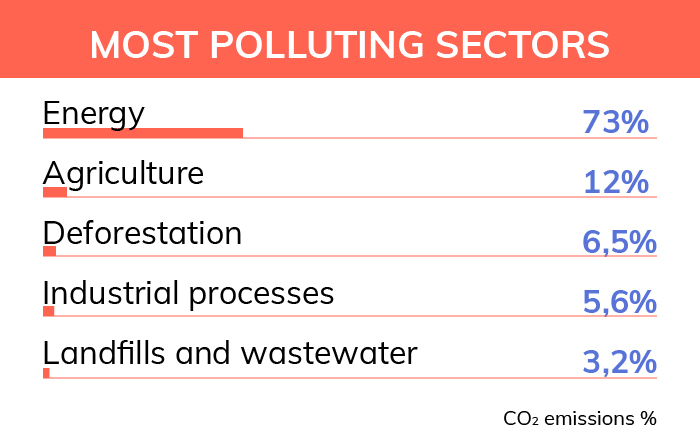It is not an easy equation, but its common denominator is the collective effort of governments, businesses and citizens around the world. Decarbonization is the ultimate challenge towards a more sustainable future.


Energy is the basis of the quality of life in modern societies, and our daily lives depend on it – from transport to health and education, from communication and information systems to trade, industry, and so on. On the other hand, it is the energy sector –including transport – that contributes the most to greenhouse gas (GHG) emissions, particularly carbon dioxide (CO2). According to Our World in Data, the energy sector accounts for about 75% of overall GHG emissions, mostly due to the burning of fossil fuels (coal, oil, and natural gas).
It is therefore necessary to intervene in the energy sector so as to reduce and, ultimately, eliminate this sector's overwhelming weight in terms of GHG emissions. First of all, we will have to replace fossil energy sources with renewable sources (link to the article on renewable energies), leading to the decarbonization of the sector. Simultaneously, we must drive the electrification of consumption in other industries and improve energy efficiency levels. And then we must offset residual emissions to achieve carbon neutrality. These two concepts – decarbonization and carbon neutrality – are global priorities for the coming decades; they will shape our future both as a society and as a planet.
The ambitious Paris Agreement decarbonization targets
With the world's population growing by the day – the UN predicts it will reach nearly 10 billion over the next three decades – and with an ever-increasing energy demand for fueling economic growth, the major challenge we face today is to accelerate the decarbonization process and involving everyone in this global effort, from national governments to businesses and anonymous citizens.
It was against this backdrop of urgency that in 2015 more than 190 countries pledged to comply with the so-called Paris Agreement: combating climate change and accelerating and intensifying the necessary measures and investment to achieve a sustainable low-carbon future – with the aim of limiting the global temperature increase to 2ºC (and preferably 1.5ºC) above pre-industrial levels by the end of the 21st century.


New technologies and a significant investment in renewable energies have made an important contribution by bringing down clean energy costs. "Suddenly there was a global critical mass to force the acceleration of technologies – not in terms of technological development as such, but in terms of bringing down their cost and making them economically competitive," says Sara Goulart from the EDP Sustainability Department's Climate and Environment area.
Even more ambitious Portuguese targets
In 2016 the European Commission announced a legislative package called 'Clean Energy for all Europeans'. The package aimed at creating the conditions for complying with the Paris Agreement, accelerating the energy transition process throughout the 2021-2030 period, and, at the same time, driving economic growth and creating jobs. As part of this package, member states undertook to draw up and deliver a National Energy and Climate Plan and to set their own GHG reduction targets, with the aim of achieving an emission reduction of 40% by 2030 (compared to 1990 figures) at a European level.
Portugal's National Energy and Climate Plan, which constitutes the country's main energy and climate policy instrument for this decade, goes even further: "it sets a national emission reduction target of 45% to 55% compared to the year 2005," says Pedro Paes from the EDP Sustainability Department's Climate and Environment area. This plan is in line with the long-term strategy set by the Portuguese Government in the Roadmap for Carbon Neutrality (RNC 2050), which aims to achieve carbon neutrality in 2050 by obtaining an 85-90% GHG reduction by 2050 and offsetting the remaining emissions through the use of land and forests.
More recently, in late 2019, the European Commission rolled out the European Green Deal, which aims at promoting the efficient use of resources, transitioning to a clean and circular economy, halting climate change, reversing biodiversity loss, and reducing pollution levels. The Green Deal sets a GHG reduction target of 55% by 2030 compared to 1990 figures – which is even more ambitious than the goal of the previous legislative package – as well as the objective of achieving carbon neutrality in the European Union by 2050.


From theory to practice: the importance of reducing bureaucracy
How can countries win the battle against climate change when figures show that 67% of the world's energy still comes from fossil fuels? Renewable energies and electrification are not the only paths to decarbonization, but they make a decisive contribution. "We must also encourage a very close dialogue between those who buy, those who sell, and those who regulate. Sometimes, extraordinary solutions emerge that help tread the decarbonization path, towards carbon neutrality, but they do not have a regulatory framework. Creating the legal mechanisms that make it possible to operationalize these extraordinary solutions takes a long time," says Sara Goulart.
Heavy dependence on coal
Along with the bureaucratic problem, heavy dependence on coal is also a major obstacle on the path to decarbonization. It is still difficult to replace coal in industrial processes, especially in countries with a highly active industry – such as China and the US – and in emerging countries like India. The alternative could be hydrogen, which offers a way to reduce the environmental impact, although it still lacks some maturity to compete with fossil fuels. And there are other renewable sources which are already treading a long and arduous path.


Among the most polluting sectors, coal-fired thermoelectric plants stand out as the main source of pollutant emissions. According to data from the World Resources Institute, the energy sector – which includes electricity production, heating, transport, industry, buildings and construction – accounts for 73% of CO2 emissions worldwide. It is followed by agriculture (12%); deforestation (6.5%); industrial processes with chemical products (5.6%); and finally, landfills and wastewater (3.2%).
As not all countries or sectors have the same conditions to achieve the much-desired decarbonization, the European Union has devised a mechanism called Fair Transition, which according to Pedro Paes is "an essential tool to make sure that the transition to a net-zero economy takes place in a fair way, and without leaving anyone behind." From 2021 to 2027 the European Union plans to allocate €100 billion to support the most coal-dependent regions and help minimize the socio-economic impact of the energy transition process.
A problem called carbon budget
"Therefore, it is very important that the US and China (link to articles on the most and least polluting countries) commit to achieving the goals set out in the Paris Agreement," says Pedro Paes. In fact, both countries have shown that they are willing to do so. With Donald Trump out of the White House, Joe Biden has put the Environment back on the US agenda by rejoining the Paris Agreement. China has also announced carbon reduction and carbon neutrality targets for 2060.
Still, the picture is far from rosy. Why? Pedro Paes answers this question by mentioning the carbon budget problem – that is, the amount of carbon dioxide emissions allowed over a period of time so that it is possible to maintain average temperatures within a certain limit. And according to this expert, such balance is still a long way from being reached. "Even if all countries comply with the commitments they have undertaken as part of the Paris Agreement, I would say that with the current figures, the temperature will rise about 3ºC by 2100 compared to pre-industrial figures. So it will not be below 2ºC, as the agreement determines." And this could have catastrophic consequences for the planet, with a rise in seawater levels and an increase in the frequency and intensity of extreme weather phenomena – droughts, floods, strong winds, forest fires, etc.
Leading by example
EDP is helping accelerate the energy transition process with a demanding decarbonization strategy that aims to make EDP a fully green company by 2030. This ambitious commitment is mostly driven by an unprecedented growth in renewable energies.

"For EDP, the goal is not just bringing energy to local communities, but helping these communities lead more sustainable lives,"
Miguel Stilwell d’Andrade, CEO of EDP
In addition to this goal, EDP has set other important targets: internally, the company has committed to reducing its carbon footprint by electrifying its entire light vehicle fleet by 2030 and by offsetting GHG emissions related to energy consumption in administrative buildings; and, externally, the company provides customers with a wide range of sustainable products and services, with special emphasis on distributed solar production, sustainable mobility, and initiatives to improve energy efficiency in all sectors of the economy.

